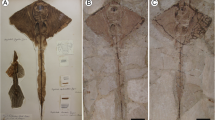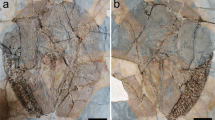Abstract
In the last few years, estimates of the patterns and timing of the evolution of the pelagic, durophagous stingrays (Myliobatidae) have improved through new comparative data from morphology, the fossil record, and DNA sequences. These recent studies are here reviewed and a conservative summary of myliobatid diversification and origins is presented. The interrelationships and morphological evolution of the durophagous stingrays are discussed, including the nature of devil rays as derived myliobatids. An exploration of myliobatid origins includes estimates of the timing of their diversification and an assessment of gymnurids as a possible sister group. The prevailing signal suggests that the most recent common ancestor of extant myliobatids was a Late Cretaceous oscillating swimmer with a pavement-like dentition. The devil ray lineage began the transition to planktivory by at least the Oligocene, with dentition gradually reduced from grinding plates of interlocking elements to long rows of homodont teeth. Finally, the validity of the genera Manta (Bancroft, 1829) and Pteromylaeus (Garman, 1913) are called into question.

Similar content being viewed by others
References
Adnet S, Cappetta H, Guinot G, Notarbartolo di Sciara G (2012) Evolutionary history of the devilrays (Chondrichthyes: Myliobatiformes) from fossil and morphological inference. Zool J Linnean Soc 166:132–159
Aschliman NC (2011) The batoid tree of life: recovering the patterns and timing of the evolution of skates, rays and allies (Chondrichthyes: Batoidea). Dissertation, Florida State University
Aschliman NC, Claeson KM, McEachran JD (2012a) Phylogeny of Batoidea. In: Carrier JC, Musick JA, Heithaus MR (eds) Biology of sharks and their relatives, 2nd edn. CRC Press, Boca Raton, pp 57–95
Aschliman NC, Nishida M, Miya M, Inoue JG, Rosana KM, Naylor GJP (2012b) Body plan convergence in the evolution of skates and rays (Chondrichthyes: Batoidea). Mol Phylogenet Evol 63:28–42. doi:10.1016/j.ympev.2011.12.012
Bigelow HB, Schroeder WC (1953) Sawfishes, guitarfishes, skates and rays. In: Tee-Van J (ed) Fishes of the western North Atlantic. Sears Foundation for Marine Research, New Haven, pp 1–514
Cappetta H (1987) Chondrichthyes II. Mesozoic and Cenozoic Elasmobranchii. In: Schultze HP (ed) Handbook of paleoichthyology, vol 3B. Gustav Fischer Verlag, Stuttgart, pp 1–193
Carvalho MR, Maisey JG, Grande L (2004) Freshwater stingrays of the Green River formation of Wyoming (Early Eocene), with the description of a new genus and species and an analysis of its phylogenetic relationships (Chondrichthyes: Myliobatiformes). Bull Am Mus Nat Hist 284:1–136
Claeson KM, O’Leary MA, Roberts EM, Sissoko F, Bouaré M, Tapanila L, Goodwin D, Gottfried MD (2010) First Mesozoic record of the stingray Myliobatis wurnoensis from Mali and a phylogenetic analysis of Myliobatidae incorporating dental characters. Acta Palaeontol Pol 55:655–674. doi:10.4202/app.2009.1117
Compagno LJV, Last PR (1999a). Myliobatidae. In: Carpenter KE, Niem VH (eds) The Living Marine Resources of the Western Central Pacific. Batoid fishes, chimaeras and bony fishes part 1 (Elopidae to Linophrynidae), vol 3. FAO, Rome, pp 1511–1519
Compagno LJV, Last PR (1999b) Mobulidae. In: Carpenter KE, Niem VH (eds) The Living Marine Resources of the Western Central Pacific. Batoid fishes, chimaeras and bony fishes part 1 (Elopidae to Linophrynidae), Vol 3. FAO, Rome, pp 1524–1529
Compagno LJV (2003) Myliobatidae. In: Smith JLB, Smith MM, Heemstra PC (eds) Smiths’ sea fishes. Struik Publishers, Cape Town, pp 132–134
Compagno LJV (2005) Checklist of living chondrichthyan fishes. In: Fowler SL, Cavanagh RD, Camhi M, Burgess GH, Caillet GM, Fordham SV, Simpfendorfer CA, Musick JA (eds) Sharks, rays, and chimaeras: the status of the chondrichthyan fishes. International Union for the Conservation of Nature, Gland, pp 401–423
Dean MN, Huber DR, Nance HA (2006) Functional morphology of jaw trabeculation in the lesser electric ray Narcine brasiliensis, with comments on the evolution of structural support in the Batoidea. J Morphol 267:1137–1146
Dunn KA, McEachran JD, Honeycutt RL (2003) Molecular phylogenetics of myliobatiform fishes (Chondrichthyes: Myliobatiformes), with comments on the effects of missing data on parsimony and likelihood. Mol Phylogenet Evol 27:259–270. doi:10.1016/S1055-7903(02)00442-6
Garman S (1913) The Plagiostoma (sharks, skates, and rays). Mem Mus Comp Zool Harv Coll 36:1–528
González-Isáis M, Domínguez HMM (2004) Comparative anatomy of the superfamily Myliobatoidea (Chondrichthyes) with some comments on phylogeny. J Morphol 262:517–535
Hamlett WC, Wourms JP, Smith JW (1985) Stingray placental analogues: structure of trophonemata in Rhinoptera bonasus. J Submicrosc Cytol 17:541–550
Herman J, Hovestadt-Euler M, Hovestadt DC, Stehmann M (2000) Contributions to the study of the comparative morphology of teeth and other relevant ichthyodorulites in living supra-specific taxa of Chondrichthyan fishes. Part B: Batomorphii 4c: order: Rajiformes - suborder Myliobatoidei - superfamily Dasyatoidea - family Dasyatidae - subfamily Dasyatinae - genus: Urobatis, subfamily Potamotrygoninae - genus: Potamotrygon, superfamily Plesiobatoidea - family Plesiobatidae - genus: Plesiobatis, superfamily Myliobatoidea - family Myliobatidae - subfamily Myliobatinae - genera: Aetobatus, Aetomylaeus, Myliobatis and Pteromylaeus, subfamily Rhinopterinae - genus: Rhinoptera and subfamily Mobulinae - Genera: Manta and Mobula. Addendum 1 to 4a: erratum to genus Pteroplatytrygon. Bull Inst R Sci Nat Belg Sci Terre 70:5–67
Human BA, Owen EP, Compagno LJV, Harley EH (2006) Testing morphologically based phylogenetic theories within the cartilaginous fishes with molecular data, with special reference to the catshark family (Chondrichthyes; Scyliorhinidae) and the interrelationships within them. Mol Phylogenet Evol 39:384–391
Jacobsen IP, Bennett MB (2009) A taxonomic review of the Australian butterfly ray Gymnura australis (Ramsay & Ogilby, 1886) and other members of the family Gymnuridae (Order Rajiformes) from the Indo-West Pacific. Zootaxa 2228:1–28
Jaekel OMJ (1894) Die eocänen Selachier vom Monte Bolca. Springer, Berlin
Kriwet J, Benton MJ (2004) Neoselachian (Chondrichthyes, Elasmobranchii) diversity across the Cretaceous-tertiary boundary. Palaeogeogr Palaeoclimatol Palaeoecol 214:181–194
Last PR, Stevens JD (2009) Sharks and rays of Australia, 2nd edn. CSIRO Publishing, Collingwood
Lovejoy NR (1996) Systematics of myliobatoid elasmobranchs: with emphasis on the phylogeny and historical biogeography of neotropical freshwater stingrays (Potamotrygonidae: Rajiformes). Zool J Linnean Soc 117:207–257
Maisey JG (1984) Higher elasmobranch phylogeny and biostratigraphy. Zool J Linnean Soc 82:33–54
Marshall AD, Compagno LJV, Bennett MB (2009) Redescription of the genus Manta with resurrection of Manta alfredi (Krefft, 1868) (Chondrichthyes; Myliobatoidei; Mobulidae). Zootaxa 2301:1–28
McEachran JD, Aschliman N (2004) Phylogeny of Batoidea. In: Carrier JC, Musick JA, Heithaus MR (eds) Biology of sharks and their relatives. CRC Press, Boca Raton, pp 79–113
McEachran JD, Dunn KA, Miyake T (1996) Interrelationships of the batoid fishes (Chondrichthyes: Batoidea). In: Stiassny MLJ, Parenti LR, Johnson GD (eds) Interrelationships of fishes. Academic, London, pp 63–82
Miyake T (1988) The systematics of the stingray genus Urotrygon with comments on the interrelationships within Urolophidae (Chondrichthyes: Myliobatiformes). Dissertation, Texas A&M University
Miyake T, McEachran JD (1991) The morphology and evolution of the ventral gill arch skeleton in batoid fishes (Chondrichthyes: Batoidea). Zool J Linnean Soc 102:75–100
Miyake T, McEachran JD, Hall BK (1992) Edgeworth’s legacy of cranial development with an analysis of muscles in the ventral gill arch region of batoid fishes (Chondrichthyes: Batoidea). J Morphol 212:213–256
Naylor GJP, Caira JN, Jensen K, Rosana KAM, White WT, Last PR (2012a) A DNA sequence-based approach to the identification of shark and ray species and its implications for global elasmobranch diversity and parasitology. Bull Am Mus Nat Hist 367:1–262
Naylor GJP, Caira JN, Jensen K, Rosana KAM, Straube N, Lakner C (2012b) Elasmobranch phylogeny: a mitochondrial estimate based on 595 species. In: Carrier JC, Musick JA, Heithaus MR (eds) Biology of sharks and their relatives, 2nd edn. CRC Press, Boca Raton, pp 31–56
Neer JA, Thompson BA (2005) Life history of the cownose ray, Rhinoptera bonasus, in the northern Gulf of Mexico, with comments on geographic variability in life history traits. Environ Biol Fish 73:321–331
Nelson JS (2006) Fishes of the world, 4th edn. Wiley, New Jersey
Nishida K (1990) Phylogeny of the suborder Myliobatidoidei. Mem Fac Fish, Hokkaido Univ 37:1–108
Notarbartolo di Sciara G (1987) A revisionary study of the genus Mobula Rafinesque, 1810 (Chondrichthyes: Mobulidae), with the description of a new species. Zool J Linnean Soc 91:1–91
Paig-Tran EWM, Kleinteich T, Summers AP (2013) The filter pads and filtration mechanisms of the devil rays: variation at macro and microscopic scales. J Morphol 274:1026–1043
Richards VP, Henning M, Witzell W, Shivji MS (2009) Species delineation and evolutionary history of the globally distributed spotted eagle ray (Aetobatus narinari). J Hered 100:273–283
Rocco L, Liguori I, Costagliola D, Morescalchi MA, Tinti F, Stingo V (2007) Molecular and karyological aspects of Batoidea (Chondrichthyes, Elasmobranchi) phylogeny. Gene 389:80–86
Schwartz FJ (1965) Inter-American migrations and systematics of the western Atlantic cownose ray, Rhinoptera bonasus. Report of the association of island marine laboratories of the Caribbean, 6th mtg
Schwartz FJ (2005) Tail spine characteristics of stingrays (order Myliobatiformes) found in the Northeast Atlantic, Mediterranean, and Black Seas. Electron J Ichthyol 1:1–9
Shirai S (1996) Phylogenetic interrelationships of neoselachians (Chondrichthyes: Euselachii). In: Stiassny MLJ, Parenti LR, Johnson GD (eds) Interrelationships of fishes. Academic, London, pp 9–34
Summers AP (2000) Stiffening the stingray skeleton—an investigation of durophagy in myliobatid stingrays (Chondrichthyes, Batoidea, Myliobatidae). J Morphol 243:113–126
Underwood CJ (2006) Diversification of the Neoselachii (Chondrichthyes) during the Jurassic and Cretaceous. Paleobiology Memoirs 32:215–235
Underwood CJ, Cumbaa SL (2010) Chondrichthyans from a Cenomanian (Late Cretaceous) bonebed, Saskatchewan, Canada. Paleobiology Memoirs 53:903–944
Underwood CJ, Mitchell SF, Veltkamp KJ (1999) Shark and ray teeth from the Hauterivian (Lower Cretaceous) of North-east England. Paleobiology Memoirs 42:287–302
Webb PW (1984) Form and function in fish swimming. Sci Am 251:72–82
White WT, Last PR, Naylor GJP, Jensen K, Caira JN (2010) Clarification of Aetobatus ocellatus (Kuhl, 1823) as a valid species, and a comparison with Aetobatus narinari (Euphrasen, 1790) (Rajiformes: Myliobatidae). In: Last PR, White WT, Pogonoski JJ (eds) Descriptions of new sharks and rays from Borneo. CSIRO marine and atmospheric research paper no. 032. CSIRO Marine and Atmospheric Research, Hobart, pp 141–164
Acknowledgments
The author gratefully acknowledges the American Elasmobranch Society and Save Our Seas Foundation for funding the durophagous stingrays symposium, and M. Ajemian and J. Neer for organizing the symposium. Two anonymous reviewers provided helpful suggestions for improving the manuscript. Travel and research support were provided by St. Ambrose University.
Author information
Authors and Affiliations
Corresponding author
Rights and permissions
About this article
Cite this article
Aschliman, N.C. Interrelationships of the durophagous stingrays (Batoidea: Myliobatidae). Environ Biol Fish 97, 967–979 (2014). https://doi.org/10.1007/s10641-014-0261-8
Received:
Accepted:
Published:
Issue Date:
DOI: https://doi.org/10.1007/s10641-014-0261-8




